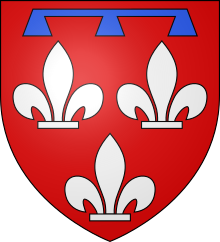William John Bates van de Weyer
William John Bates van de Weyer (1870– 1 April 1946) was a British Militia officer who won lasting fame in horticulture as the first to hybridize a South American species of Buddleja with an Asiatic species while on leave during World War I.

Working in the nursery of his home, Smedmore House,
Weyer also hybridized B. globosa with B. madagascariensis circa 1920 and, several years later, B. globosa with B. brasiliensis,[2] though neither appears to have had much horticultural merit and no cultivars are known.
Career
Weyer was the son of
Soon afterwards he was appointed as an
He retired from the militia on 3 May 1905 with the honorary rank of Major,[10] and emigrated to Kenya, where he bought and managed a dairy farm 15 miles west of Nairobi.[11] On the outbreak of World War I in 1914 he returned as a captain[12] to his former battalion, which was training reinforcements for the Regular Army.
Weyer held the office of High Sheriff of Dorset in 1942.[3][5]
Personal life
Weyer married the Hon. Olive Elizabeth Wingfield (1885–1978), eldest daughter of
Honours and arms
Weyer was invested as a Member of the Royal Victorian Order (MVO) in 1900.[3] His hybrid buddleja cultivar 'Golden Glow' was accorded the Award of Merit by the Royal Horticultural Society in 1923.

|
|
Publications
Weyer, W. van de (1920). “Buddleja weyeriana” in Gardeners' Chronicle ser. 3, 68: 181. 1920.
References
- ^ Bean, W. J. (1950). Trees and Shrubs Hardy in the British Isles 7th Edition. John Murray, London.
- ^ Moore, R. J. (1949). Cytotaxonomic studies in the Loganiaceae. III. Artificial hybrids in the genus Buddleja L. American Journal of Botany. Vol. 36, No. 7 (Jul., 1949), p. 511.
- ^ a b c d Mosley, C. (Ed.). (2003).Burke's Peerage, Baronetage & Knightage, 107th edition. Vol. 1, p. 1130. Burke's Peerage (Genealogical Books) Ltd., Wilmington, Delaware, USA.
- ^ a b c Emma Elizabeth Thoyts, History of the Royal Berkshire Militia (Now 3rd Battalion Royal Berks Regiment), Sulhamstead, Berks, 1897/Scholar Select, ISBN 978-1-37645405-5, pp. 215, 323.
- ^ a b Townend, P. (Ed.). Burke's Genealogical and Heraldic History of the Landed Gentry, 18th edition. Vol. 1, p. 686. Burke's Peerage Ltd, 1965-1972, London, England.
- ^ London Gazette, 3 January 1890.
- ^ London Gazette, 11 June 1895.
- ^ London Gazette, 1 October 1895.
- ^ London Gazette, 11 May 1900.
- ^ London Gazette, 5 May 1905.
- ^ Ayre, P. Europeans in East Africa
- ^ London Gazette, 25 September 1914.
- ^ International Plant Names Index. Weyer.
